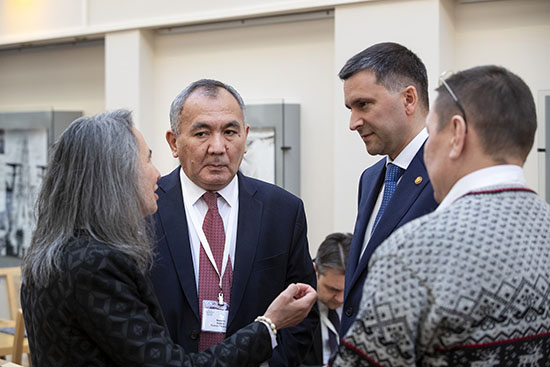The Arctic Environment Ministers have travelled to Rovaniemi to discuss climate change, biodiversity and pollution prevention and to seek solutions for these pressing issues.
High-level delegates from the eight Arctic states and six Permanent Participant organizations representing the indigenous peoples of the Arctic have joined them. Their host is Kimmo Tiilikainen, Minister of the Environment, Energy and Housing of Finland.
On Thursday morning, President of the Finnish Sámi Parliament Tiina Sanila-Aikio urged the meeting participants to pay attention to Mother Earth. To facilitate environmental action, she emphasised the importance of cooperation between indigenous peoples and the decision-makers at the regional level.
Secretary-General of the World Meteorological Organization Petteri Taalas shared chilling facts about global warming and its impacts. Arctic has warmed twice as fast as the global average. Carbon dioxide emissions are the factor behind the warming. CO² levels in the atmosphere are the highest in three million years. Acidification threatens the oceans.
“These changes have fundamental consequences for the nature, and for humans”, said Marianne Kroglund, who chairs the Arctic monitoring and Assessment program AMAP.
“They have social and cultural implications. Traditional livelihoods in the Arctic region are under increasing pressure.”
Pollution prevention, especially actions to help clear marine litter and actions to prevent plastic pollution were the topics of the second panel.
Principal Deputy Assistant Secretary Judith G. Garber said that the U.S. take marine litter seriously. The Arctic countries are not the major plastic pollutants, but the Arctic seas also suffer the consequences.
“We are used to getting our shrimp sandwiches wrapped in plastic, but soon the shrimps themselves will be full of plastic”, alerted the Icelandic Minister Gudmundur Ingi Gudbrandsson.
Dalee Sambo Dorough, the Chair of the Inuit Circumpolar Council reminded that the indigenous peoples in the Arctic suffer the full extent and impact of micro plastics.
“We often see in the other parts of the world that the indigenous peoples only get to experience the downside of economic development. The Arctic states can set a precedent in this dynamic. We can do it right, consider the social and cultural rights of the indigenous peoples and combine scientific data with indigenous knowledge to resolve the challenges.”
At its best, Arctic cooperation is face-to-face discussions with colleagues from across the world, who share some of the same experiences and concerns. These encounters are now taking place in Rovaniemi, on the level of ministers, but also between experts, researchers and students. On Thursday afternoon, the ministers joined the Arctic Biodiversity Congress participants. The Arctic Youth Summit had prepared a declaration for the ministers to demand ambitious measures to protect the Arctic and to integrate the voices of the youth into decision-making.
Top of page: The distinguished panel discussed the possibilities for joint environmental action.
End of page: ICC Chair Dalee Sambo Dorough, Director at the Ministry of Natural Resources and Environment Nuridtin Inamov and and Minister of Natural Resources of the Russian Federation Dmitry Kobylkin and Raipon President Grigory Ledkov talk during a break.
Photos (c) Ministry of the Environment.

Photo (c) Ministry of the Environment.